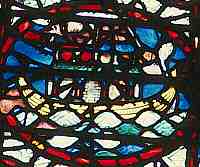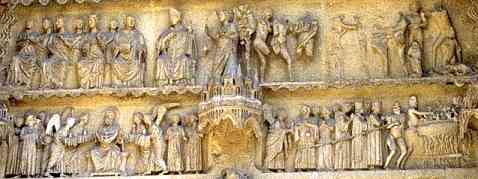 |
|
Drama
(2) |
|
Passion
Plays had been performed in Italy, France and Switzerland during the 13th
century, partly in Latin and partly in the vernacular.
The Corpus Christi Plays set the Passion within the whole of time, starting
with the Creation and ending with the Last Judgement. It was an edited
version, of course, but it could still take all day, or even several.
Episodes from the Old
Testament were selected which were seen to prefigure events of the
New Testament. For example, Noah's flood prefigures the Last Judgement.
Such schemes were also followed in many forms of medieval art, which drew
a great deal of its expression from the staging of these plays. |
|
|
Noah's
ark in a stained glass window in Lincoln cathedral. Models of the ark were
built for the plays. |
|
|
A
Last Judgement scene on a tympanum of Rheims Cathedral. |
|
The
grand climax of the play was an enactment of the Last Judgement. This theme
was depictedly prominently in medieval church art in places where the laity
could see them, notably carved on the tympana of the portals in major French
churches. In England, the scene was painted all over the chancel arch of parish
churches. It all provided something to think about! |
|
The
Corpus Christi plays are often referred to as the Mystery
Plays, the origin of the name being a bit of a mystery itself. One
explanation which applies to the English plays, that they were put on
by the town craft guilds and that it refers to the mysteries, or skills,
of the crafts, does not hold up as the French plays were also referred
to as Mystères, and they were not generally conducted by craft
guilds. In France, Italy and Spain special guilds or societies were generally
set up for the purpose of organising the plays. |
|
The
complexity of the plays and their method of production varied from place to
place. Even the timing could change as some were performed at times other
than the feast of Corpus Christi. They all had in common that they were performed
in the vernacular, by members of the laity, outside the church. An elaborate
procession announcing the event was mounted some weeks beforehand, getting
the populace into a state of eager anticipation. In Continental Europe the
heart of a town, with its marketplaces and buildings, could be taken over
as the acting arena. The creation of an imaginary, theatrical space within
a real space seems to have been a notable characteristic of the plays. |
|
| Depiction
of the acting area of a performance of a Passion Play at Valenciennes in 1547,
from a manuscript in the Bibliothèque Nationale. |
|
In
the above example, Paradise is located on top of a pavilion on the left, while
the mouth of Hell spews demons from a building on the right. A pond with a
boat in it is labelled as the sea, while various other structures, including
what appear to be the town gates, are labelled as the Temple, Nazareth, Jerusalem
and other significant places in the play. |
|
The
performance could consist of a long series, or cycle, of plays which covered
the whole range of subject matter, or a simpler subset. Plays could be performed
in a special purpose acting space, or on temporary platforms arranged in an
existing space. In Cornwall they were performed in special circular enclosures
called, imaginatively, rounds, two of which still survive. This drops a hint
of possible re-use of ancient amphitheatres or monuments. In relation to the
English plays, the greatest elaboration came in the form of the great cycles,
performed by the craft guilds of major towns, and in some cases performed
on elaborate pageant wagons which trundled through the streets from dawn to
dusk with each set of actors repeatedly performing their segment at different
locations through the town. |
 |
A
depiction of an improvised stage, from a copy of a miniature in a manuscript
in the library at Cambrai. |
|
Survival
of actual manuscripts
of these plays is relatively sparse. The effective suppression of the
plays at the Reformation undoubtedly had much to do with it, but it seems
that they were not squirrelled away by collectors, as were more highly
valued manuscripts. Perhaps, unlike the French example referred to above,
they were not produced in fancy illuminated
codices, but existed
as scruffy working documents which did not attract collectors. That certainly
seems to be the case with surviving manuscripts. |
|
Only
four complete English cycles survive: those of York in one manuscript,
Chester in five very late antiquarian copies, the Towneley cycle from
Wakefield in one copy and a cycle from an unidentified place in the East
Midlands known, inaccurately, as the Ludus Coventriae,
or the N-town cycle, in one manuscript. Some other individual plays survive
in manuscript form. However, other documentary evidence or individual
plays indicate that cycles were performed in Aberdeen, Bath, Beverley,
Bristol, Brome, Canterbury, Coventry , Dublin, Ipswich, Leicester, Lincoln,
London, Newcastle, Northampton, Norwich and Worcester. The surviving plays
show a complex pattern of shared and borrowed work between them, but so
many pieces of the jigsaw are missing that it is impossible to work out
the patterns. |
|
continued
 |
 previous page
previous page |
 Categories
of Works Categories
of Works |
|
 |
 |
 |





